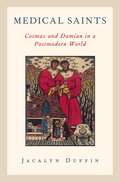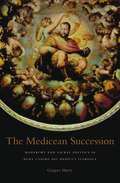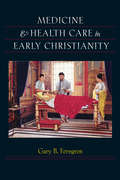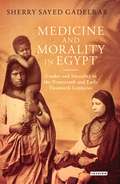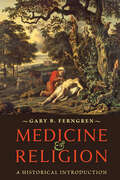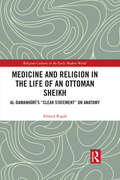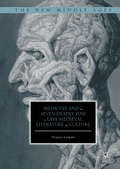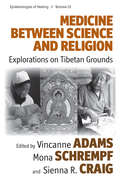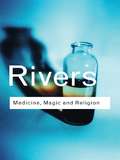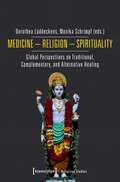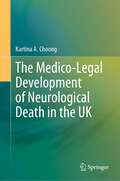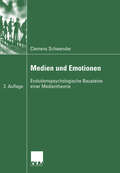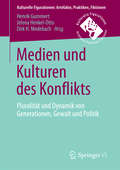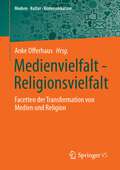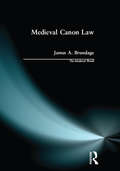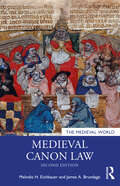- Table View
- List View
Medical Saints: Cosmas and Damian in a Postmodern World
by Jacalyn DuffinCosmas and Damian were martyred around the year 300 A.D. in what is now Syria. Called the Anargyroi ("without silver") because they charged no fees, they became patrons of medicine, surgery, and pharmacy and the focus of cults ranging across Europe. They were popular in Byzantine and Orthodox traditions and their shrines are numerous in Eastern Europe, southern Italy, and Sicily. The Medici family of Florence viewed the "santi medici" as patrons, and their deeds were illustrated by great Renaissance artists. In medical literature they are now revered as patrons of transplantation. Jacalyn Duffin offers a profound exploration of illness and healing experiences in contemporary society through the veneration of the twin doctors Saints Cosmas and Damian. She also relates a personal journey, from her role as a hematologist who unexpectedly came to serve as an expert witness in the Church's evaluation of a miracle to her research as a historican on the origins, meaning, and functions of saints. Duffin's research, which includes interviews with devotees in both North America and Europe, focuses on how people have taken the saints with them as they moved both within Italy and beyond. She shows that veneration of Cosmas and Damian has spread beyond immigrant traditions to fill important functions in healthcare and healing. Duffin's conclusions provide essential insights into medical history, sociology, anthropology, and popular religion, as well as the current medical debate over spiritual healing. Medical Saints draws on medical history and Roman Catholic traditions, but extends to universal observations about the behaviors of sick people and the formal responses to individual illness from collectivities in religion, medicine, and history.
Medical Saints: Cosmas and Damian in a Postmodern World
by Jacalyn DuffinCosmas and Damian were martyred around the year 300 A.D. in what is now Syria. Called the Anargyroi ("without silver") because they charged no fees, they became patrons of medicine, surgery, and pharmacy and the focus of cults ranging across Europe. They were popular in Byzantine and Orthodox traditions and their shrines are numerous in Eastern Europe, southern Italy, and Sicily. The Medici family of Florence viewed the "santi medici" as patrons, and their deeds were illustrated by great Renaissance artists. In medical literature they are now revered as patrons of transplantation. Jacalyn Duffin offers a profound exploration of illness and healing experiences in contemporary society through the veneration of the twin doctors Saints Cosmas and Damian. She also relates a personal journey, from her role as a hematologist who unexpectedly came to serve as an expert witness in the Church's evaluation of a miracle to her research as a historican on the origins, meaning, and functions of saints. Duffin's research, which includes interviews with devotees in both North America and Europe, focuses on how people have taken the saints with them as they moved both within Italy and beyond. She shows that veneration of Cosmas and Damian has spread beyond immigrant traditions to fill important functions in healthcare and healing. Duffin's conclusions provide essential insights into medical history, sociology, anthropology, and popular religion, as well as the current medical debate over spiritual healing. Medical Saints draws on medical history and Roman Catholic traditions, but extends to universal observations about the behaviors of sick people and the formal responses to individual illness from collectivities in religion, medicine, and history.
The Medicean Succession: Monarchy and Sacral Politics in Duke Cosimo dei Medici's Florence (I Tatti studies in Italian Renaissance history #14)
by Gregory MurryCosimo dei Medici stabilized ducal finances, secured his borders, doubled his territory, attracted scholars and artists to his court, academy, and universities, and dissipated fractious Florentine politics. These triumphs were far from a foregone conclusion, as Gregory Murry shows in this study of how Cosimo crafted his image as a sacral monarch.
The Medicean Succession: Monarchy and Sacral Politics in Duke Cosimo dei Medici's Florence (I Tatti studies in Italian Renaissance history #14)
by Gregory MurryCosimo dei Medici stabilized ducal finances, secured his borders, doubled his territory, attracted scholars and artists to his court, academy, and universities, and dissipated fractious Florentine politics. These triumphs were far from a foregone conclusion, as Gregory Murry shows in this study of how Cosimo crafted his image as a sacral monarch.
Medicine and Health Care in Early Christianity
by Gary B. FerngrenDrawing on New Testament studies and recent scholarship on the expansion of the Christian church, Gary B. Ferngren presents a comprehensive historical account of medicine and medical philanthropy in the first five centuries of the Christian era.Ferngren first describes how early Christians understood disease. He examines the relationship of early Christian medicine to the natural and supernatural modes of healing found in the Bible. Despite biblical accounts of demonic possession and miraculous healing, Ferngren argues that early Christians generally accepted naturalistic assumptions about disease and cared for the sick with medical knowledge gleaned from the Greeks and Romans.Ferngren also explores the origins of medical philanthropy in the early Christian church. Rather than viewing illness as punishment for sins, early Christians believed that the sick deserved both medical assistance and compassion. Even as they were being persecuted, Christians cared for the sick within and outside of their community. Their long experience in medical charity led to the creation of the first hospitals, a singular Christian contribution to health care.
Medicine and Health Care in Early Christianity
by Gary B. FerngrenDrawing on New Testament studies and recent scholarship on the expansion of the Christian church, Gary B. Ferngren presents a comprehensive historical account of medicine and medical philanthropy in the first five centuries of the Christian era.Ferngren first describes how early Christians understood disease. He examines the relationship of early Christian medicine to the natural and supernatural modes of healing found in the Bible. Despite biblical accounts of demonic possession and miraculous healing, Ferngren argues that early Christians generally accepted naturalistic assumptions about disease and cared for the sick with medical knowledge gleaned from the Greeks and Romans.Ferngren also explores the origins of medical philanthropy in the early Christian church. Rather than viewing illness as punishment for sins, early Christians believed that the sick deserved both medical assistance and compassion. Even as they were being persecuted, Christians cared for the sick within and outside of their community. Their long experience in medical charity led to the creation of the first hospitals, a singular Christian contribution to health care.
Medicine and Health Care in Early Christianity
by Gary B. FerngrenDrawing on New Testament studies and recent scholarship on the expansion of the Christian church, Gary B. Ferngren presents a comprehensive historical account of medicine and medical philanthropy in the first five centuries of the Christian era.Ferngren first describes how early Christians understood disease. He examines the relationship of early Christian medicine to the natural and supernatural modes of healing found in the Bible. Despite biblical accounts of demonic possession and miraculous healing, Ferngren argues that early Christians generally accepted naturalistic assumptions about disease and cared for the sick with medical knowledge gleaned from the Greeks and Romans.Ferngren also explores the origins of medical philanthropy in the early Christian church. Rather than viewing illness as punishment for sins, early Christians believed that the sick deserved both medical assistance and compassion. Even as they were being persecuted, Christians cared for the sick within and outside of their community. Their long experience in medical charity led to the creation of the first hospitals, a singular Christian contribution to health care.
Medicine and Morality in Egypt: Gender and Sexuality in the Nineteenth and Early Twentieth Centuries (Library of Middle East History)
by Sherry Sayed GadelrabIn Middle Eastern and Islamic societies, the politics of sexual knowledge is a delicate and often controversial subject. Sherry Sayed Gadelrab focuses on nineteenth and early-twentieth century Egypt, claiming that during this period there was a perceptible shift in the medical discourse surrounding conceptualisations of sex differences and the construction of sexuality. Medical authorities began to promote theories that suggested men's innate 'active' sexuality as opposed to women's more 'passive' characteristics, interpreting the differences in female and male bodies to correspond to this hierarchy. Through examining the interconnection of medical, legal, religious and moral discourses on sexual behaviour, Gadelrab highlights the association between sex, sexuality and the creation and recreation of the concept of gender at this crucial moment in the development of Egyptian society. By analysing the debates at the time surrounding science, medicine, morality, modernity and sexuality, she paints a nuanced picture of the Egyptian understanding and manipulation of the concepts of sex and gender
Medicine and Religion: A Historical Introduction
by Gary B. FerngrenMedicine and Religion is the first book to comprehensively examine the relationship between medicine and religion in the Western tradition from ancient times to the modern era. Beginning with the earliest attempts to heal the body and account for the meaning of illness in the ancient Near East, historian Gary B. Ferngren describes how the polytheistic religions of ancient Mesopotamia, Egypt, Greece, and Rome and the monotheistic faiths of Judaism, Christianity, and Islam have complemented medicine in the ancient, medieval, and modern periods.Ferngren paints a broad and detailed portrait of how humans throughout the ages have drawn on specific values of diverse religious traditions in caring for the body. Religious perspectives have informed both the treatment of disease and the provision of health care. And, while tensions have sometimes existed, relations between medicine and religion have often been cooperative and mutually beneficial. Religious beliefs provided a framework for explaining disease and suffering that was larger than medicine alone could offer. These beliefs furnished a theological basis for a compassionate care of the sick that led to the creation of the hospital and a long tradition of charitable medicine.Praise for Medicine and Health Care in Early Christianity, by Gary B. Ferngren"This fine work looks forward as well as backward; it invites fuller reflection of the many senses in which medicine and religion intersect and merits wide readership."—JAMA"An important book, for students of Christian theology who understand health and healing to be topics of theological interest, and for health care practitioners who seek a historical perspective on the development of the ethos of their vocation."—Journal of Religion and Health
Medicine and Religion: A Historical Introduction
by Gary B. FerngrenMedicine and Religion is the first book to comprehensively examine the relationship between medicine and religion in the Western tradition from ancient times to the modern era. Beginning with the earliest attempts to heal the body and account for the meaning of illness in the ancient Near East, historian Gary B. Ferngren describes how the polytheistic religions of ancient Mesopotamia, Egypt, Greece, and Rome and the monotheistic faiths of Judaism, Christianity, and Islam have complemented medicine in the ancient, medieval, and modern periods.Ferngren paints a broad and detailed portrait of how humans throughout the ages have drawn on specific values of diverse religious traditions in caring for the body. Religious perspectives have informed both the treatment of disease and the provision of health care. And, while tensions have sometimes existed, relations between medicine and religion have often been cooperative and mutually beneficial. Religious beliefs provided a framework for explaining disease and suffering that was larger than medicine alone could offer. These beliefs furnished a theological basis for a compassionate care of the sick that led to the creation of the hospital and a long tradition of charitable medicine.Praise for Medicine and Health Care in Early Christianity, by Gary B. Ferngren"This fine work looks forward as well as backward; it invites fuller reflection of the many senses in which medicine and religion intersect and merits wide readership."�JAMA"An important book, for students of Christian theology who understand health and healing to be topics of theological interest, and for health care practitioners who seek a historical perspective on the development of the ethos of their vocation."�Journal of Religion and Health
Medicine and Religion in the Life of an Ottoman Sheikh: Al-Damanhuri’s "Clear Statement" on Anatomy (Religious Cultures in the Early Modern World)
by Ahmed RagabIn 1768, Aḥmad al-Damanhūrī became the rector (shaykh) of al-Azhar, which was one of the most authoritative and respected positions in the Ottoman Empire. He occupied this position until his death. Despite being a prolific author, whose writings are largely extant, al-Damanhūrī remains almost unknown, and much of his work awaits study and analysis. This book aims to shed light on al-Damanhūrī’s diverse intellectual background, and that of and his contemporaries, building on and continuing the scholarship on the academic thought of the late Ottoman Empire. The book specifically investigates the intersection of medical and religious knowledge in Eighteenth-Century Egypt. It takes as its focus a manuscript on anatomy by al-Damanhūrī (d. 1778), entitled "The Clear Statement on the Science of Anatomy (al-qawl al-ṣarīḥ fī ʿilm al-tashrīḥ),". The book includes an edited translation of The Clear Statement, which is a well-known but unstudied and unpublished manuscript. It also provides a summary translation and analysis of al-Damanhūrī’s own intellectual autobiography. As such, the book provides an important window into a period that remains deeply understudied and a topic that continues to cause debates and controversies. This study, therefore, will be of keen interest to scholars working on the "post-Classical" Islamic world, as well as historians of religion, science, and medicine looking beyond Europe in the Early Modern period.
Medicine and Religion in the Life of an Ottoman Sheikh: Al-Damanhuri’s "Clear Statement" on Anatomy (Religious Cultures in the Early Modern World)
by Ahmed RagabIn 1768, Aḥmad al-Damanhūrī became the rector (shaykh) of al-Azhar, which was one of the most authoritative and respected positions in the Ottoman Empire. He occupied this position until his death. Despite being a prolific author, whose writings are largely extant, al-Damanhūrī remains almost unknown, and much of his work awaits study and analysis. This book aims to shed light on al-Damanhūrī’s diverse intellectual background, and that of and his contemporaries, building on and continuing the scholarship on the academic thought of the late Ottoman Empire. The book specifically investigates the intersection of medical and religious knowledge in Eighteenth-Century Egypt. It takes as its focus a manuscript on anatomy by al-Damanhūrī (d. 1778), entitled "The Clear Statement on the Science of Anatomy (al-qawl al-ṣarīḥ fī ʿilm al-tashrīḥ),". The book includes an edited translation of The Clear Statement, which is a well-known but unstudied and unpublished manuscript. It also provides a summary translation and analysis of al-Damanhūrī’s own intellectual autobiography. As such, the book provides an important window into a period that remains deeply understudied and a topic that continues to cause debates and controversies. This study, therefore, will be of keen interest to scholars working on the "post-Classical" Islamic world, as well as historians of religion, science, and medicine looking beyond Europe in the Early Modern period.
Medicine and the Seven Deadly Sins in Late Medieval Literature and Culture (The New Middle Ages)
by Virginia LangumThis book considers how scientists, theologians, priests, and poets approached the relationship of the human body and ethics in the later Middle Ages. Is medicine merely a metaphor for sin? Or can certain kinds of bodies physiologically dispose people to be angry, sad, or greedy? If so, then is it their fault? Virginia Langum offers an account of the medical imagery used to describe feelings and actions in religious and literary contexts, referencing a variety of behavioral discussions within medical contexts. The study draws upon medical and theological writing for its philosophical basis, and upon more popular works of religion, as well as poetry, to show how these themes were articulated, explored, and questioned more widely in medieval culture.
Medicine Between Science and Religion: Explorations on Tibetan Grounds (Epistemologies of Healing #10)
by Vincanne Adams, Mona Schrempf and Sienna R. CraigThere is a growing interest in studies that document the relationship between science and medicine - as ideas, practices, technologies and outcomes - across cultural, national, geographic terrain. Tibetan medicine is not only known as a scholarly medical tradition among other Asian medical systems, with many centuries of technological, clinical, and pharmacological innovation; it also survives today as a complex medical resource across many Asian nations - from India and Bhutan to Mongolia, Tibet (TAR) and China, Buryatia - as well as in Western Europe and the Americas. The contributions to this volume explore, in equal measure, the impacts of western science and biomedicine on Tibetan grounds - i.e., among Tibetans across China, the Himalaya and exile communities as well as in relation to globalized Tibetan medicine - and the ways that local practices change how such “science” gets done, and how this continually hybridized medical knowledge is transmitted and put into practice. As such, this volume contributes to explorations into the bi-directional flows of medical knowledge and practice.
Medicine, Magic and Religion
by W.H.R. RiversOne of the most fascinating men of his generation, W.H.R. Rivers was a British doctor and psychiatrist as well as a leading ethnologist. Immortalized as the hero of Pat Barker's award-winning Regeneration trilogy, Rivers was the clinician who, in the First World War, cared for the poet Siegfried Sassoon and other infantry officers injured on the western front. His researches into the borders of psychiatry, medicine and religion made him a prominent member of the British intelligentsia of the time, a friend of H.G. Wells, George Bernard Shaw and Bertrand Russell. Part of his appeal lay in an extraordinary intellect, mixed with a very real interest in his fellow man. Medicine, Magic and Religion is a prime example of this. A social institution, it is one of Rivers' finest works. In it, Rivers introduced the then revolutionary idea that indigenous practices are indeed rational, when viewed in terms of religious beliefs.
Medicine, Magic and Religion
by W.H.R. RiversOne of the most fascinating men of his generation, W.H.R. Rivers was a British doctor and psychiatrist as well as a leading ethnologist. Immortalized as the hero of Pat Barker's award-winning Regeneration trilogy, Rivers was the clinician who, in the First World War, cared for the poet Siegfried Sassoon and other infantry officers injured on the western front. His researches into the borders of psychiatry, medicine and religion made him a prominent member of the British intelligentsia of the time, a friend of H.G. Wells, George Bernard Shaw and Bertrand Russell. Part of his appeal lay in an extraordinary intellect, mixed with a very real interest in his fellow man. Medicine, Magic and Religion is a prime example of this. A social institution, it is one of Rivers' finest works. In it, Rivers introduced the then revolutionary idea that indigenous practices are indeed rational, when viewed in terms of religious beliefs.
Medicine of the Person: Faith, Science and Values in Health Care Provision (PDF)
by Ahmed Okasha Alastair Campbell Andrew Sims Bernard Ruedi Claire Hilton Dinesh Bhugra Hans-Rudolf Pfeifer John Clark John Cox Julia Neuberger Martin Conway Michael Hilton Mike Magee Peter Gilbert Robert Atwell Thierry Collaud Tom Fryers Bill K. W. M. FulfordMedicine of the Person is an international, multi-faith exploration of the demonstrable need to integrate the scientific basis of healthcare more fully with spiritual, religious and ethical values. Informed by the principle of 'medicine of the person', the contributors argue for a medical practice which takes account of personal relationships, spirituality, ethics and theology in keeping with the ideas and beliefs of Paul Tournier, an influential Swiss general practitioner whose thinking has had a substantial impact on routine patient care relevant to national health services. Bridging the gap between the basic sciences and faith traditions, the contributors discuss notions of personhood in different faiths and its consideration in spirituality and mental health issues, general practice issues, public health, home care for the elderly and neuroscience. This volume offers a broad spectrum of approaches to the needs of patients and is a key text for students of the health disciplines, and practitioners and managers in these fields.
Medicine - Religion - Spirituality: Global Perspectives on Traditional, Complementary, and Alternative Healing (Religionswissenschaft #13)
by Dorothea Lüddeckens Monika SchrimpfIn modern societies the functional differentiation of medicine and religion is the predominant paradigm. Contemporary therapeutic practices and concepts in healing systems, such as Transpersonal Psychology, Ayurveda, as well as Buddhist and Anthroposophic medicine, however, are shaped by medical as well as religious or spiritual elements. This book investigates configurations of the entanglement between medicine, religion, and spirituality in Europe, Asia, North America, and Africa. How do political and legal conditions affect these healing systems? How do they relate to religious and scientific discourses? How do therapeutic practitioners position themselves between medicine and religion, and what is their appeal for patients?
The Medico-Legal Development of Neurological Death in the UK
by Kartina A. ChoongDiagnosis of death by neurological criteria (DNC) is a construct which has been part of the British medico-legal landscape for nearly half a century. This book examines the factors behind its emergence, and discusses the various changes that took place in the last few decades that culminated in the current definition and clinical criteria for determining brain-based death. It highlights the continuities and discontinuities in practice, and the impact they have on the issue of withdrawal of mechanical ventilation in intensive care units and on the field of organ transplantation. The book also explores the law’s response to the introduction and development of DNC in clinical practice. It demonstrates how the legitimacy of the definition and criteria used by the medical profession were forged in the courtroom rather than in Parliament. It documents why case law were introduced in court, and assesses whether organ donation was a consideration in the deliberations. It will be emphasised that courts have given insufficient consideration to requests made in recent cases to consider a broader range of methods to determine death. Those pleas were made on the grounds that the definition and criteria used in the UK are dissimilar to those used in other jurisdictions that also adopt DNC; and that faith communities have a different understanding of death. By taking a close look at those other approaches before highlighting the inherent limitations of the courtroom as the forum that confers DNC its legitimacy, the book puts forward the argument that the democratic process should be engaged.
Medien und Emotionen: Evolutionspsychologische Bausteine einer Medientheorie
by Clemens SchwenderClemes Schwender nutzt die Erkenntnisse der Evolutionspsychologie, um die Frage zu beantworten, warum die Menschen so viel Zeit mit Medien verbringen.
Medien und Kulturen des Konflikts: Pluralität und Dynamik von Generationen, Gewalt und Politik (Kulturelle Figurationen: Artefakte, Praktiken, Fiktionen)
by Henrik Gummert Jelena Henkel-Otto Dirk H. MedebachDer Sammelband beruht auf der Annahme, dass Medientechnologien, Medienpraktiken sowie Medienbilder und die Konstitution und Vermittlung sozialer Realität in einem reziproken Verhältnis zueinander stehen. Es werden kulturell-normative Deutungsmuster sowie Rezeptionspraktiken transportiert, die weitgehende Implikationen auf Gesellschaft haben. Digitale Informations- und Kommunikationstechnologien erweitern mediale Darstellungen, Diskurse und Verhandlungen sozialer Konflikte. Im Zuge dessen werden gleichsam private Konflikte, das Konflikthandeln selbst, zunehmend medienvermittelt. Entsprechende kulturelle Aneignungs- und Rezeptionsprozesse von Akteuren führen zu neuen Konfliktfigurationen. Die dabei entstehenden Konfliktformen werden in unterschiedlichen Massenmedien aufgegriffen, was eine intermediale Komponente von Konfliktkommunikation zum Ausdruck bringt.
Medienvielfalt - Religionsvielfalt: Facetten der Transformation von Medien und Religion (Medien • Kultur • Kommunikation)
by Anke OfferhausAusgehend von der kommunikativen Konstruktion von Religion analysiert der Band die grundlegende Fragen, welchen Stellenwert Medien für die Konstruktion religiöser sozialer Wirklichkeiten haben und in welchem Verhältnis dabei Medienwandel und der Wandel von Religion stehen. Der interdisziplinäre Sammelband zielt vor dem Hintergrund des Mediatisierungsansatzes auf die Zusammenführung der bislang wechselseitig wenig zur Kenntnis genommenen sozialwissenschaftlichen Forschungen renommierter deutschsprachiger Wissenschaftler/innen. Darüber hinaus widmet er sich einem in allen Disziplinen bislang wenig diskutiertem Zusammenhang, nämlich dem Verhältnis von Medien und Religion im sozialen Wandel.
Medieval Canon Law (The Medieval World)
by James A BrundageIt is impossible to understand how the medieval church functioned -- and in turn influenced and controlled the lay world within its care -- without understanding the development, character and impact of `canon law', its own distinctive law code. However important, this can seem a daunting subject to non-specialists. They have long needed an attractive but authoritative introduction, avoiding arid technicalities and setting the subject in its widest context. James Brundage's marvellously fluent and accessible book is the perfect answer: it will be warmly welcomed by medievalists and students of ecclesiastical and legal history.
Medieval Canon Law (The Medieval World)
by James A BrundageIt is impossible to understand how the medieval church functioned -- and in turn influenced and controlled the lay world within its care -- without understanding the development, character and impact of `canon law', its own distinctive law code. However important, this can seem a daunting subject to non-specialists. They have long needed an attractive but authoritative introduction, avoiding arid technicalities and setting the subject in its widest context. James Brundage's marvellously fluent and accessible book is the perfect answer: it will be warmly welcomed by medievalists and students of ecclesiastical and legal history.
Medieval Canon Law (The Medieval World)
by James A. Brundage Melodie H. EichbauerIt is impossible to understand how the medieval church functioned and, in turn, influenced the lay world within its care without understanding "canon law". This book examines its development from its beginnings to the end of the Middle Ages, updating its findings in light of recent scholarly trends. This second edition has been fully revised and updated by Melodie H. Eichbauer to include additional material on the early Middle Ages; the significance of the discovery of earlier versions of Gratian’s Decretum; and the new research into law emanating from secular authorities, councils, episcopal acta, and juridical commentary to rethink our understanding of the sources of law and canon law's place in medieval society. Separate chapters examine canon law in intellectual spaces; the canonical courts and their procedures; and, using the case studies of deviation from orthodoxy and marriage, canon law in the lives of people. The main body of the book concludes with the influence of canon law in Western society, but has been reworked by integrating sections cut from the first edition chapters on canon law in private and public life to highlight the importance of this field of research. Throughout the work and found in the bibliography are references to current literature and resources in order to make researching in the field more accessible. The first appendix provides examples of how canonical texts are cited while the second offers biographical notes on canonists featured in the work. The end result is a second edition that is significantly rewritten and updated but retains the spirit of Brundage’s original text. Covering all aspects of medieval canon law and its influence on medieval politics, society, and culture, this book provides students of medieval history with an accessible overview of this foundational aspect of medieval history.
